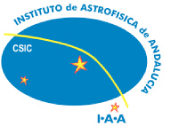New findings on Titan reinforce astrobiological interest: active chemistry, clouds and methane showers
The study, based on data from three instruments of the James Webb Space Telescope, offers new insights into the chemistry and atmosphere of Titan, the densest and most stable of all the moons in the solar system.
Among the findings of the study, in which the Instituto de Astrofísica de Andalucía (IAA-CSIC) is participating, the first direct detection of methyl radical (CH₃) in Titan's atmosphere stands out, confirming key predictions about its organic chemistry.
Another of the most revealing findings has been achieved thanks to JWST's NIRSpec instrument, a near-infrared spectrograph with which it has been possible to measure the concentration of carbon monoxide (CO) in Titan's atmosphere from the surface to the upper atmosphere (above 800 km altitude). The observations extend the previous profiles, limited to 450 km, and confirm that the CO concentration remains constant in all layers. Thus, the fact that CO remains constant from the troposphere to the exosphere indicates that the oxygen it contains is not generated on Titan, but comes from outside.
On the other hand, by combining JWST data with those from the W. M. Keck ground-based observatory, clouds were detected at mid and high latitudes in the northern hemisphere that appeared to ascend with the passage of days. Although cloud convection had already been documented in the Southern Hemisphere, this is the first time this phenomenon has been observed in the northern summer hemisphere.The study, based on data from three instruments of the James Webb Space Telescope, offers new insights into the chemistry and atmosphere of Titan, the densest and most stable of all the moons in the solar system.
Among the findings of the study, in which the Instituto de Astrofísica de Andalucía (IAA-CSIC) is participating, the first direct detection of methyl radical (CH₃) in Titan's atmosphere stands out, confirming key predictions about its organic chemistry.
Another of the most revealing findings has been achieved thanks to JWST's NIRSpec instrument, a near-infrared spectrograph with which it has been possible to measure the concentration of carbon monoxide (CO) in Titan's atmosphere from the surface to the upper atmosphere (above 800 km altitude). The observations extend the previous profiles, limited to 450 km, and confirm that the CO concentration remains constant in all layers. Thus, the fact that CO remains constant from the troposphere to the exosphere indicates that the oxygen it contains is not generated on Titan, but comes from outside.
On the other hand, by combining JWST data with those from the W. M. Keck ground-based observatory, clouds were detected at mid and high latitudes in the northern hemisphere that appeared to ascend with the passage of days. Although cloud convection had already been documented in the Southern Hemisphere, this is the first time this phenomenon has been observed in the northern summer hemisphere.
Ref: ‘The atmosphere of Titan in late northern summer from JWST and Keck observations’, https://www.nature.com/articles/s41550-025-02537-3
https://www.iaa.csic.es/noticia/nuevos-hallazgos-sobre-titan-refuerzan-s...




